怎样变一般疑问句和否定句
陈述句变一般疑问句和肯定句变否定句的几点技巧
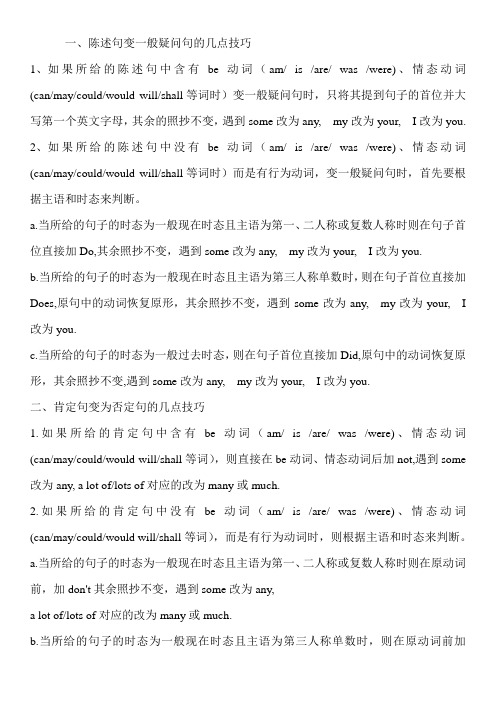
一、陈述句变一般疑问句的几点技巧1、如果所给的陈述句中含有be动词(am/ is /are/ was /were)、情态动词(can/may/could/would will/shall等词时)变一般疑问句时,只将其提到句子的首位并大写第一个英文字母,其余的照抄不变,遇到some改为any, my改为your, I改为you.2、如果所给的陈述句中没有be动词(am/ is /are/ was /were)、情态动词(can/may/could/would will/shall等词时)而是有行为动词,变一般疑问句时,首先要根据主语和时态来判断。
a.当所给的句子的时态为一般现在时态且主语为第一、二人称或复数人称时则在句子首位直接加Do,其余照抄不变,遇到some改为any, my改为your, I改为you.b.当所给的句子的时态为一般现在时态且主语为第三人称单数时,则在句子首位直接加Does,原句中的动词恢复原形,其余照抄不变,遇到some改为any, my改为your, I 改为you.c.当所给的句子的时态为一般过去时态,则在句子首位直接加Did,原句中的动词恢复原形,其余照抄不变,遇到some改为any, my改为your, I改为you.二、肯定句变为否定句的几点技巧1.如果所给的肯定句中含有be动词(am/ is /are/ was /were)、情态动词(can/may/could/would will/shall等词),则直接在be动词、情态动词后加not,遇到some 改为any, a lot of/lots of对应的改为many或much.2.如果所给的肯定句中没有be动词(am/ is /are/ was /were)、情态动词(can/may/could/would will/shall等词),而是有行为动词时,则根据主语和时态来判断。
a.当所给的句子的时态为一般现在时态且主语为第一、二人称或复数人称时则在原动词前,加don't其余照抄不变,遇到some改为any,a lot of/lots of对应的改为many或much.b.当所给的句子的时态为一般现在时态且主语为第三人称单数时,则在原动词前加doesn't原句中的动词恢复原形,其余照抄不变,遇到some改为any,a lot of/lots of对应的改为many或much.c.当所给的句子的时态为一般过去时态,则在原动词前加didn't原句中的动词恢复原形,其余照抄不变,遇到some改为any,a lot of/lots of对应的改为many或much.将下列句子变为一般疑问句和否定句1. His father is an English teacher.2. These cats are crying.3. They can swim.4. I like to read English.5. I go to school on foot.6. He likes English.7. His father goes to work by bus.8. He is crying under the tree.9. His birthday is on the twentieth of November.10. Mrs. Li and Kitty are in a big shop.11. Kitty is wearing her new uniform.12. The boy under the tree is hungry.13. He goes to school every day.14. I want to have a model car.15.She wants a cup of coffee.16. Mrs. Li and Kitty watch television at night.17. I do my homework after school.。
陈述句变疑问句和否定句
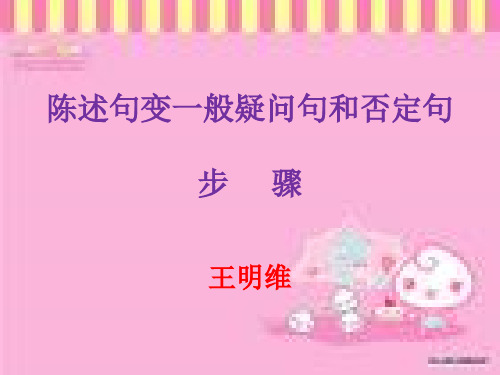
1.We always go to school on foot every day. We always don’t go to school on foot every day. 2.They went to the hospital to see their good friend, Tom. They didn’t go to the hospital to see their good friend ,Tom. 3.My good friend has two eggs and a glass of milk in the morning before he goes to school. My good friend doesn’t have two eggs or a glass of milk in the morning before he doesn’t go to school .
1.The twins are watching TV now. The twins are not(aren’t) watching TV now. 2.They were in the front of the classroom. They were not(weren’t) in the front of the classroom. 3.The child can play the piano very well. The child can not(can’t)play the piano very well. 4.We students should help each other in study . We students should not(shouldn’t) help each other in study.
变否定句和疑问句
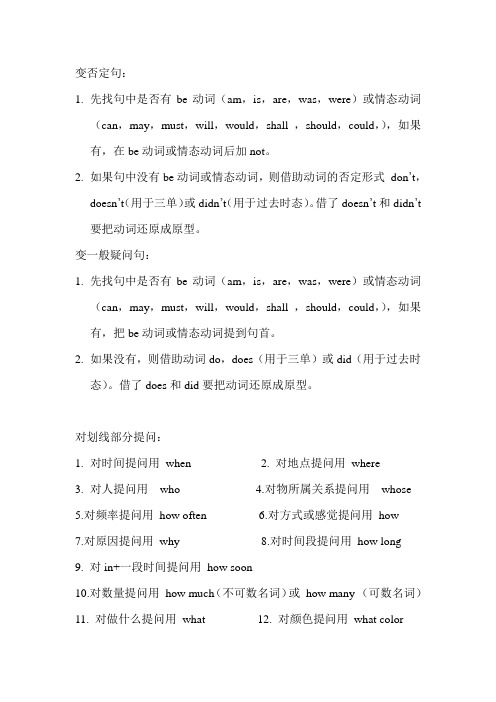
变否定句:
1.先找句中是否有be动词(am,is,are,was,were)或情态动词
(can,may,must,will,would,shall ,should,could,),如果有,在be动词或情态动词后加not。
2.如果句中没有be动词或情态动词,则借助动词的否定形式don’t,
doesn’t(用于三单)或didn’t(用于过去时态)。
借了doesn’t和didn’t 要把动词还原成原型。
变一般疑问句:
1.先找句中是否有be动词(am,is,are,was,were)或情态动词
(can,may,must,will,would,shall ,should,could,),如果有,把be动词或情态动词提到句首。
2.如果没有,则借助动词do,does(用于三单)或did(用于过去时
态)。
借了does和did要把动词还原成原型。
对划线部分提问:
1.对时间提问用when
2. 对地点提问用where
3.对人提问用who
4.对物所属关系提问用whose
5.对频率提问用how often
6.对方式或感觉提问用how
7.对原因提问用why 8.对时间段提问用how long
9. 对in+一段时间提问用how soon
10.对数量提问用how much(不可数名词)或how many (可数名词)
11. 对做什么提问用what 12. 对颜色提问用what color。
怎样变一般疑问句、否定句和特殊疑问句
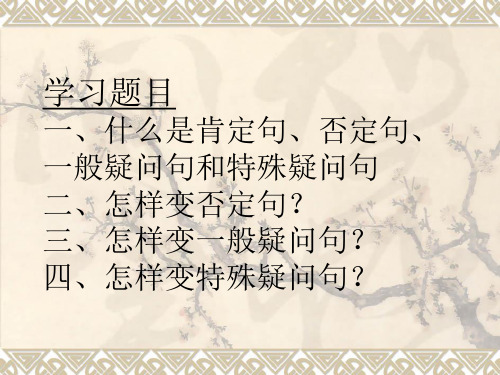
二、怎样变否定句
有am,
is, are的句子, 肯定句变否定句:在am, is, are后面加上not,其 余按顺序照抄。 例如:I am a boy. I am not a boy. He is a teacher. He is not a teacher. They are friends. They are not friends. 他们是朋友。 他们不是朋友。
学习题目
一、什么是肯定句、否定句、 一般疑问句和特殊疑问句 二、怎样变否定句? 三、怎样变一般疑问句? 四、怎样变特殊疑问句?
一、be动词:am,
is, are 二、肯定句、否定句、一般疑问句和特殊 疑问句定义 1.肯定句:表示肯定的意思, 即不含有否 定词“不”。 比如:我是一个学生 I am a student. 他是一个老师。He is a teacher. 2.否定句:表示否定的意思。 比如:我不是一个男孩。 I am not a boy 他不是一个老师。 He is not a teacher.
一般疑问句:回答为“是yes”或者“否no” 的问句。 比如:你是一个学生吗? Are you a student? Yes, I am./No, I am not. 4. 特殊疑问句:回答不是“是yes”或者“否 no”的问句,而是根据提问内容具体回答。 比如:这是什么? What’s this? It is a map.
四、怎样变特殊疑问句?
就划线部分提问(变特殊疑问句)
This
is a book. 第一步:变一般疑问句 Is this a book? 第二步:找合适的特殊疑问词 Is this what ? 第三步:特殊疑问词提前放到句首,并大写, 其余按顺序照抄,省略划线部分。得出正确 答案:What is this?
变否定句和一般疑问句的小窍门

如何做句型转换一、如何变否定句先看句子中有没有系动词am,is are,was,were 和情态动词can,may,must,need,will和would,1、如果有的话,变否定句时就在这些词后加not例如:He is my friend.—He is not my friend.You can sing songs.—You can’t sing songs.2.如果没有那些词的话,就在主语之后,谓语动词之前加don’t或doesn’t。
加don’t 还是doesn’t ,主要取决于动词的形式A:动词用原形时,在它的前面加don’t,动词本来是原形,不需要变化。
例如:We make lunch every day.—We don’t make lunch every day. B: 动词用单三时,在它的前面加doesn’t,然后将动词变为原形;例如:He wants apples for lunch .—He doesn’t want apples for lunch .二、如何变一般疑问句先看句子中有没有系动词am,is are,was,were 和情态动词can,may,must,need,will和would,1、如果有的话,就将他们提前大写加问号“?”例如:He is my friend.—Is he your friend?I can sing songs.—Can you sing songs?2、如果没有那些词的话,就在句首加Do或Does。
加Do还是Does,也取决于动词的形式A:动词用原形时,在句首加Do,动词本来就是原形,不需要变化。
We make lunch every day.—Do you make lunch every day?B: 动词用单三时,在句首加Does,然后将动词变为原形。
例如:He wants apples for lunch . —Does he want apples for lunch ?。
陈述句变否定句一般疑问句特殊疑问句及练习

句型转换的方法一、肯定句改否定句的方法——一步法1、在be动词后加not;如:is not , are not , am not, was not, were not;2、在can,should, will等后加not;如:cannot, should not, will not;3、上述都没有的,在动词前加助动词否定形式don’t/doesn’t/didn’t;4、 some 改成any;把下面的句子变成否定句;1.She is watching TV now.2.We go to school on Sunday.3.His father works hard.4.Jack's mother is a nurse.5.The cat runs fast.6.They like reading books.7.My grandpa gives me a hot dog.8.Tom often walks to school.9.I have a doll.It is eating fish.二、肯定句改一般疑问句的方法——三步法1、把be动词放在句首,剩下的照抄,some 改成any,my改成your等句点改成问号;2、把can,shall, will等放到句首,剩下的照抄,some 改成any,my改成your 等句点改成问号;例如:陈述句: They are in the park. He can play the guitar..一般疑问句: Are they in the park Can he play the guitar把下列句子变成一般疑问句1. I am listening to music.______________________________________2. Mike is a student._______________________________________3. Sarah can clean the classroom.________________________________________4. They are in the zoo.________________________________________5. There are some flowers in the vase.________________________________________6.This is my sister._________________________________________7.We are sweeping the floor.__________________________________________3、上述都没有的,在句首请助动词Do/Does/Did帮忙,剩下的照抄,some 改成any,my改成your等句点改成问号;例如:陈述句: I like the ducks. He likes the dogs.一般疑问句:Do you like the ducks Does he like the dogs把下列句子改为一般疑问句;1. We need some masks._________________________________2. They like making the puppet._________________________________3. Su Hai and Su Yang live in a new house._________________________________________________4.I put a book on my head._________________________________________________5. They sing “In the classroom”together._________________________________________________6.We play basketball on Sundays._________________________________________________7. Tom likes listening to music____________________________________________三、肯定句改特殊疑问句的方法——四步法1、在一般疑问句的基础上,句首添加一个疑问词即可,可根据划线部分确定是什么疑问词;2、接着找be动词或can,shall, will等放在疑问词后面,若没有则请助动词do/does/did帮忙,写在疑问词后面,how many除外,必须先写物品,再写be动词等;3、划线部分去掉后剩下的内容照抄,some 改成any,my改成your等4、句点改成问号;以疑问词开头,对句中某一成分提问的句子叫特殊疑问句;常用的疑问词有:what什么, who谁, whose谁的, which哪个, when何时, where 哪里, how怎样, why为何等;1.what意为“什么”,用来对“事”或“职业”提问;What is this 这个是什么What is your father 你爸爸是做什么的2. who意为“谁”,用来对“人”提问;Who is behind the door谁在门后3. whose意为“谁的”,用来对物主代词及名词所有格进行提问;Whose bag is this这个包是谁的4. which意为“哪个”,既可以对“人”提问,也可以对“物”提问;which season do you like best 你最喜欢哪个季节5. when意为“什么时候”,对时间提问;对具体钟点提问用“what time”;When did you arrive你什么时候到的What time does the first class begin几点钟开始第一堂课6. why 意为“为什么”,对原因提问;Why are you late 你为什么迟到Why don’t we go to together 我们为什么不一起去7. where 意为“在哪里”,对地点提问;where is lily Lily在哪里8. how 意为“怎样”,对方式、程度、状态等提问;How are you today 你今天怎么样句型转换题1.The girl is singing in the classroom.改为否定句改为一般疑问句2.They are looking for bag.对画线部分提问3.I am riding my bike now.同上4.There are twelve studens over there.同上5.I can speak English.改为一般疑问句6.I am writing now.同上7.She is buying some food in the supermarket.改为否定句8.I am ill. 对画线部分提问9.Does she like growing flowers 给予否定回答10.I will make model planes with my classmates on Sunday. 对画线部分提问11.The waiter and the waitress play table tennis every day. 改为否定句12.The boy is standing on the man's shoulders.改为一般疑问句13.It's ten o'clock.对画线部分提问练一练1、A: _______ is the boy in blue B:He’s Mike.2、A: _______ pen is itB:It’s mine.3、A: _______ is the diary B:It’s under the chair.4、A: ___ is the Chirstmas Day B: It’s on the 25th of December.5、A: _______ are the earphones B:They are 25 yuan.6、A: _______ is the cup B:It’s blue.7、A: _______ is it today B:It’s Sunday.8、A: _______ was it yesterday B: It was the 13th of October.9、A: _______ this red one B:It’s beautiful.10、A: Can I have some paper and some crayonsB: _______ A: I want to make a kite.12A:_______ is your cousin B: He’s 15 years old.13、A:_______ do you have dinnerB: At 6 o’clock.1.He does well in Maths. 改为否定句2.Mike runs as fast as Ben. 改为一般疑问句3.Jim is good at English and Maths. 对画线部分提问4. The policeman caught the thief. 改为一般疑问句,作否定回答5. Turn right at the third crossing. 改为否定句6.How can I get to the shopping centre 改为同义句7.Are they American cars 改为单数8.Don’t go along this street. 改为肯定句9.I get to the shopping centre by bus. 对画线部分提问10.It always rains in summer there. 改为一般疑问句,作肯定回答11.It’s cold in winter there. 对画线部分提问12.I like autumn best. 改为否定句13.Su Yang is asking Ben some questions. 对画线部分提问14.Please turn off the light. 改为否定句15.I know his telephone number. 改为一般疑问句16.The children have school today. 改为否定句17.I’d like to join them.改为一般疑问句18. They are going to see a film tomorrow. 对画线部分提问19.I like collecting stamps and singing. 改为否定句20.He often cleans his bedroom. 改为一般疑问句21.Liu Tao is watering flowers in the garden. 对画线部分提问22.David and Mike are going to planting trees this afternoon. 对画线部分提问23.He did his homework in the classroom. 改为否定句24.Wang Bing is heavier than Gao Shan. 对画线部分提问25.Tom jumps as far as Mike. 改为否定句26.The boy can jump higher than the girl. 改为否定句27.Liu Tao needs some pencils. 改为否定句28.Mary can fly. 变为一般疑问句,并作否定回答29.He has a brother. 改为一般疑问句30.Nancy drew some pictures yesterday. 改为否定句。
1、陈述句变否定句和一般疑问句2018年5月3日总结

变一般疑问句的方法:(一调,二变,三问号)一、当句中有Be(am,is,are)动词的时候,1、将Be(am,is,are)提前,放于句首(大写);2、将人称变换,第一人称变第二人称(I→you,we→you,my→your,our→your),第二人称变第一人称(you→I,you→we,your→my,your→our),第三人称不变(一变二,二变一,三不变)3、在句尾加问号“?”4、回答:肯定:Yes , 主语+be.(答语中的主语须与问句的主语一致,必须用主格代词)否定:No, 主语+be+not.(即答语中的主语须与问句的主语一致,必须用主格代词)二、当句中没有Be动词,有情态动词,时候1、将提前can,放于句首(大写);2、将人称变换,第一人称变第二人称(I→you,we→you,my→your,our→your),第二人称变第一人称(you→I,you→we,your→my,your→our),第三人称不变(一变二,二变一,三不变)3、在句尾加问号“?”4、回答:肯定:Yes , 主语+can.(即答语中的主语须与问句的主语一致,必须用主格代词)否定:No, 主语+can+not.(即答语中的主语须与问句的主语一致,必须用主格代词)三、句中没有Be动词和情态动词can的时候1、在句首加Do或Does,当主语是第三人称单数的时候用Does,其它都用Do2、将人称变换,第一人称变第二人称(I→you,we→you,my→your,our→your),第二人称变第一人称(you→I,you→we,your→my,your→our),第三人称不变(一变二,二变一,三不变)3、在句尾加问号“?”4、回答:肯定:Yes , 主语+do/does(即答语中的主语须与问句的主语一致,必须用主格代词)否定:No, 主语+do/does+not.(即答语中的主语须与问句的主语一致,必须用主格代词)其它在句中要变换的词有some→any, am→are英语里只有三种人称.第一人称:我,我们,(I),we 【me,us】(我),我们第二人称:你,你们,(you),you 【you ,you】( 你),你们第三人称:他,她,它(he,she,it,) 【him,her ,it 】他们they【them】还有一些人名也算第三人称,比如Kangkang,Jane.像your father(你的爸爸)这也算第三人称. 第三人称单数指他(he) 她(she) 它(it)或者单个人名,第三人称复数是都用they 他们/她们/它们此外,不可数名词在用法上也同于第三人称单数。
陈述句改为一般疑问句和否定句
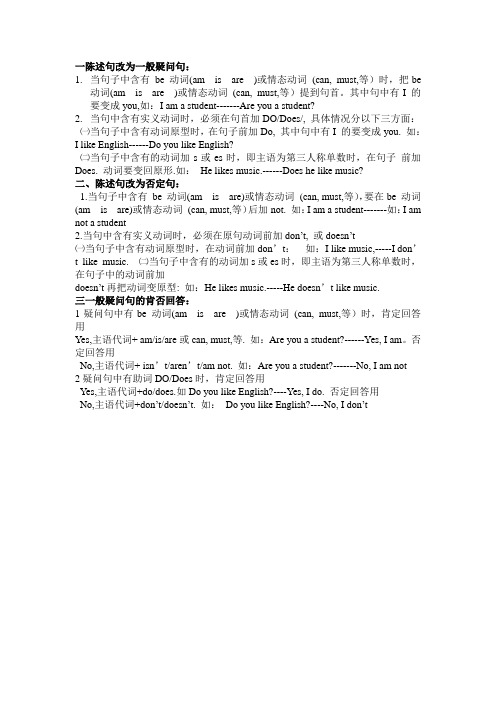
一陈述句改为一般疑问句:1.当句子中含有be 动词(am is are )或情态动词(can, must,等)时,把be动词(am is are )或情态动词(can, must,等)提到句首。
其中句中有I 的要变成you,如:I am a student-------Are you a student?2.当句中含有实义动词时,必须在句首加DO/Does/, 具体情况分以下三方面:㈠当句子中含有动词原型时,在句子前加Do, 其中句中有I 的要变成you. 如:I like English------Do you like English?㈡当句子中含有的动词加s或es时,即主语为第三人称单数时,在句子前加Does. 动词要变回原形.如:He likes music.------Does he like music?二、陈述句改为否定句:1.当句子中含有be 动词(am is are)或情态动词(can, must,等),要在be 动词(am is are)或情态动词(can, must,等)后加not. 如:I am a student-------如:I am not a student2.当句中含有实义动词时,必须在原句动词前加don’t, 或doesn’t㈠当句子中含有动词原型时,在动词前加don’t:如:I like music,-----I don’t like music. ㈡当句子中含有的动词加s或es时,即主语为第三人称单数时,在句子中的动词前加doesn’t再把动词变原型: 如:He likes music.-----He doesn’t like music.三一般疑问句的肯否回答:1疑问句中有be 动词(am is are )或情态动词(can, must,等)时,肯定回答用Yes,主语代词+ am/is/are或can, must,等. 如:Are you a student?------Yes, I am。
肯定句变一般疑问句的规则
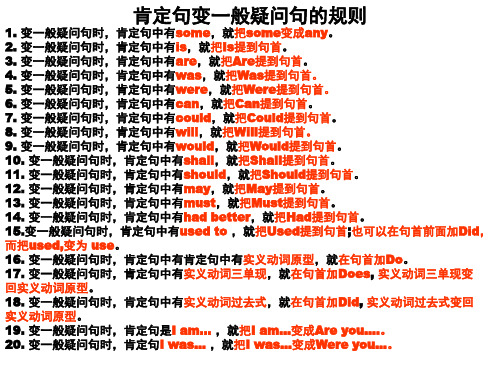
肯定句变一般疑问句的规则
变为一般疑问句
1. She is doing some cleaning. any Is she doing ________ _____ cleaning? 2. They were watching TV at this time yesterday. _____ ________ TV at this time yesterday? Were they watching 3. She goes bicycling twice a week. ______ Does she _____ go bicycling twice a week? 4. She has to clean the classroom every day. _____ Does she _____ have to clean the classroom every day? 5. She does morning exercises every day. _____ morning exercises every day? Does she _____do do 6. We did morning exercises yesterday. _____ Did you _____ do morning exercises yesterday? *7. Jim used to be a policeman. ______ Used Jim _____ to be a policeman?
变否定句时肯定句中有实义动词过去式就在这个实义动词过去式前加didnt实义动词变为否定句1
1. 变一般疑问句时,肯定句中有some,就把some变成any。 2. 变一般疑问句时,肯定句中有is,就把Is提到句首。 3. 变一般疑问句时,肯定句中有are,就把Are提到句首。 4. 变一般疑问句时,肯定句中有was,就把Was提到句首。 5. 变一般疑问句时,肯定句中有were,就把Were提到句首。 6. 变一般疑问句时,肯定句中有can,就把Can提到句首。 7. 变一般疑问句时,肯定句中有could,就把Could提到句首。 8. 变一般疑问句时,肯定句中有will,就把Will提到句首。 9. 变一般疑问句时,肯定句中有would,就把Would提到句首。 10. 变一般疑问句时,肯定句中有shall,就把Shall提到句首。 11. 变一般疑问句时,肯定句中有should,就把Should提到句首。 12. 变一般疑问句时,肯定句中有may,就把May提到句首。 13. 变一般疑问句时,肯定句中有must,就把Must提到句首。 14. 变一般疑问句时,肯定句中有had better,就把Had提到句首。 15.变一般疑问句时,肯定句中有used to ,就把Used提到句首;也可以在句首前面加Did, 而把used,变为 use。 16. 变一般疑问句时,肯定句中有肯定句中有实义动词原型,就在句首加Do。 17. 变一般疑问句时,肯定句中有实义动词三单现,就在句首加Does, 实义动词三单现变 回实义动词原型。 18. 变一般疑问句时,肯定句中有实义动词过去式,就在句首加Did, 实义动词过去式变回 实义动词原型。 19. 变一般疑问句时,肯定句是I am… ,就把I am…变成Are you….。 20. 变一般疑问句时,肯定句I was… ,就把I was…变成Were you…。
怎样变一般疑问句和否定句

4. I have a bag . _D_o__y_o_u__h_a_v_e__a_b_a_g_?__________________________
2.)has 旳一般疑问句: a. He has a soccer ball .(变一般疑问句)
Does he have a soccer ball ? b. She has a ping-pang bat . (变一般疑问句)
Does she a have ping-pang bat ?
c. Jane has a tennis racket . (变一般疑问句)
I am a boy.----------- Are you a boy?
二.have/has旳一般疑问句:
1.)have 旳一般疑问句: a. I have a book .(变一般疑问句)
Do you have a book ? b. They have many books . (变一般疑问句)
b. They have many books . (变一般否定句)
They don’t have many books .
c. We have mve many baseballs .
小结: have旳否定句是在主语和have之间加上助动词 ”don’t” , 注 意: “don’t” 是加上去旳,不是原句里面旳。
2. Li Lei has a volleyball . _L_i L_e_i__d_o_e_sn_’__t_h_a_v_e_a__vo_l_le_y_b_a_ll_._______________
八种时态句子怎样变一般疑问句和否定句
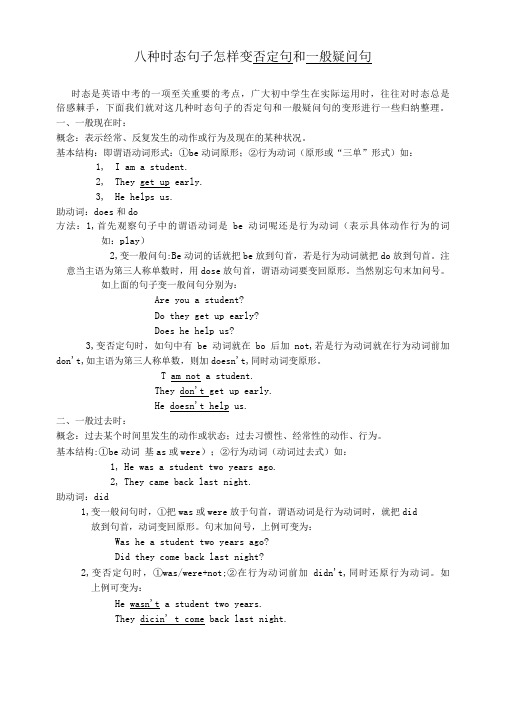
八种时态句子怎样变否定句和一般疑问句时态是英语中考的一项至关重要的考点,广大初中学生在实际运用时,往往对时态总是倍感棘手,下面我们就对这几种时态句子的否定句和一般疑问句的变形进行一些归纳整理。
一、一般现在时:概念:表示经常、反复发生的动作或行为及现在的某种状况。
基本结构:即谓语动词形式:①be动词原形;②行为动词(原形或“三单”形式)如:1,I am a student.2,They get up early.3,He helps us.助动词:does和do方法:1,首先观察句子中的谓语动词是be动词呢还是行为动词(表示具体动作行为的词如:play)2,变一般问句:Be动词的话就把be放到句首,若是行为动词就把do放到句首。
注意当主语为第三人称单数时,用dose放句首,谓语动词要变回原形。
当然别忘句末加问号。
如上面的句子变一般问句分别为:Are you a student?Do they get up early?Does he help us?3,变否定句时,如句中有be动词就在bo后加not,若是行为动词就在行为动词前加don't,如主语为第三人称单数,则加doesn't,同时动词变原形。
T am not a student.They don't get up early.He doesn't help us.二、一般过去时:概念:过去某个时间里发生的动作或状态;过去习惯性、经常性的动作、行为。
基本结构:①be动词基as或were);②行为动词(动词过去式)如:1,He was a student two years ago.2,They came back last night.助动词:did1,变一般问句时,①把was或were放于句首,谓语动词是行为动词时,就把did 放到句首,动词变回原形。
句末加问号,上例可变为:Was he a student two years ago?Did they come back last night?2,变否定句时,①was/were+not;②在行为动词前加didn't,同时还原行为动词。
否定句和一般疑问句的变化规则
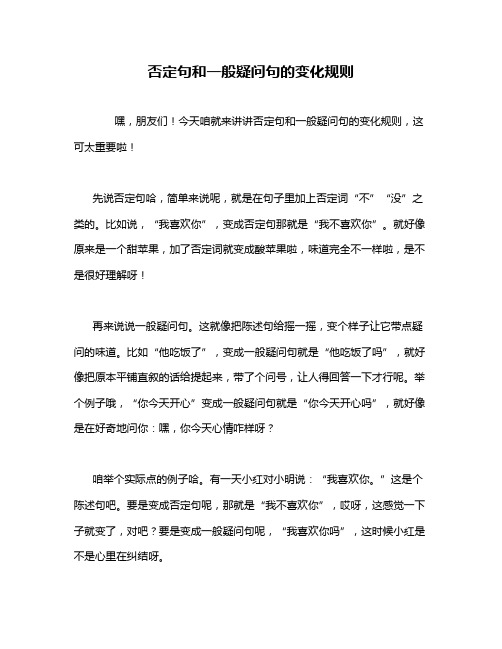
否定句和一般疑问句的变化规则
嘿,朋友们!今天咱就来讲讲否定句和一般疑问句的变化规则,这可太重要啦!
先说否定句哈,简单来说呢,就是在句子里加上否定词“不”“没”之类的。
比如说,“我喜欢你”,变成否定句那就是“我不喜欢你”。
就好像原来是一个甜苹果,加了否定词就变成酸苹果啦,味道完全不一样啦,是不是很好理解呀!
再来说说一般疑问句。
这就像把陈述句给摇一摇,变个样子让它带点疑问的味道。
比如“他吃饭了”,变成一般疑问句就是“他吃饭了吗”,就好像把原本平铺直叙的话给提起来,带了个问号,让人得回答一下才行呢。
举个例子哦,“你今天开心”变成一般疑问句就是“你今天开心吗”,就好像是在好奇地问你:嘿,你今天心情咋样呀?
咱举个实际点的例子哈。
有一天小红对小明说:“我喜欢你。
”这是个陈述句吧。
要是变成否定句呢,那就是“我不喜欢你”,哎呀,这感觉一下子就变了,对吧?要是变成一般疑问句呢,“我喜欢你吗”,这时候小红是不是心里在纠结呀。
对于否定句和一般疑问句的变化规则,真的要掌握好呀,不然说话表达可能就不准确啦!不管是在日常交流,还是学习写作中,都超级有用的呀!总之,一定要好好学起来,这样才能让我们的语言更加丰富、准确!这就是我的看法,你们觉得呢?。
五年级陈述句变否定和一般疑问句
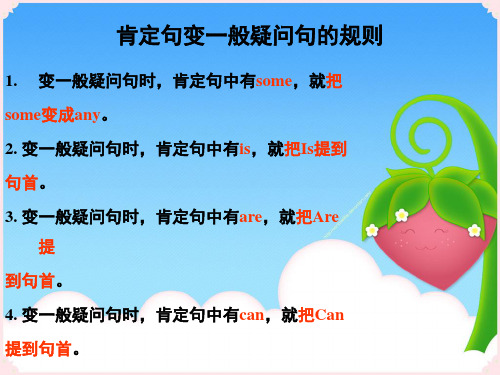
对划线部分提问1
1. What
1)对物和事提问。
2)对前面出现了name的人名提问。
3)对数字本身提问。
4)对表示职业的名词(a doctor, a teacher 等)提问。 2. What do…do ?对除第三人称外的人称提问。 3. What does…do? 对第三人称单数提问。 4. What did…do? 对动词过去式提问。 5. What be the weather like…?
缩写。
3. 变否定句时,肯定句中有is,就在is后加not, is not缩写成 isn’t。
4. 变否定句时,肯定句中有are,就在are后加not, are not缩 写成aren’t。
5. 变否定句时,肯定句中有was,就在was后加not, was not 缩写成wasn’t。
6. 变否定句时,肯定句中有can,就在can后加not, can not缩写成can’t 或cannot。
对划线部分提问
1. I’m feeling very well today.
_H__o_w__ __a_r_e__ you feelinபைடு நூலகம் today?
2. Ann spends at least an hour in the gym every day. _H__o_w_ __lo_n_g__ does Ann spend in the gym every day?
7. 变否定句时,肯定句中有实义动词原型,就在这个实义
动词原型前加don’t。
8. 变否定句时,肯定句中有实义动词三单现,就在这个实
义动词三单现前加doesn’t, 实义动词三单现变回实义
动词原型。
变为否定句
一般现在时的肯定句变一般疑问句和否定句方法2014-10-24 0.27.56

一般现在时的肯定句变一般疑问句和否定句方法一:变一般疑问句必知知识:系动词be动词的分类情态动词can、would等助动词will等(暂时不用掌握)行为动词(run、likes、wants等)什么是第三人称单数?由表格可以看出第三人称单数是He、she、it。
注意单数名词作主语也看做第三人称单数。
He、she、it单数名词。
如单个的地名、人名等所以简单来说第三人称单数是不定代词如everything/something 等指示代词this/that1.变一般疑问句的思路:看谓语动词,如果谓语动词是系动词be (am/is/are)、助动词、或情态动词,则只需将它们提到主语之前。
如果没有(肯定就是行为动词的原形(如run、like、)或三单(如runs、likes),则在句首加上Do或Does。
2具体方法⑴当谓语是系动词be (am/is/are)、助动词、或情态动词时运用一提、二改、三问号。
一提,就是将系动词be (am/is/are)、助动词、或情态动词提到主语之前,下面主要讲解be动词的一般疑问句。
一提:把is/are提到主语之前(注意碰到I am改为Are you,然后将讲I am后面的抄上)二改:1.改大小写2. 改人称,就是把第一人称的主格和形容词性物主代词改为第二人称的主格和形容词性物主代词。
即将,you,your,your。
3. 改词将三问号,就是把句号变成问号。
re you in Class Five?Is your mother a a doctor?He is a boy. Is he a boy? 肯回Yes,he is. 否回No,he isn‘t.Are you students?总结:该系列一般疑问句句式系动词(Is、Are)+主语+表语+其他+?情态动词+主语+动原+其他+?助动词句式略⑵当谓语动词为行为动词的原形(如run、like、)或三单(如runs、likes),则在句首加上Do或Does。
- 1、下载文档前请自行甄别文档内容的完整性,平台不提供额外的编辑、内容补充、找答案等附加服务。
- 2、"仅部分预览"的文档,不可在线预览部分如存在完整性等问题,可反馈申请退款(可完整预览的文档不适用该条件!)。
- 3、如文档侵犯您的权益,请联系客服反馈,我们会尽快为您处理(人工客服工作时间:9:00-18:30)。
注意: “Does” 是加上去的,不是原句里面的。
三.将下列句子变为一般疑问句:
1. Maria and Meimei have a room . Do Maria and Meimei have a room ? ____________________________________________ 2. Li Lei has a volleyball . Does Li Lei have a volleyball ? _________________________________________ 3. She has a backpack . Does she a backpack ? ___________________________________________ 4. I have a bag .
三.将下列句子变为否定句: 1. Maria and Meimei have a room .
Maria and Meimei don’t have a room ____________________________________________
2. Li Lei has a volleyball .
4. I have a bag .
I don’t have a bag. ___________________________________________
5. That’s an English book . That isn’t an English book. _____________________________________________ 6. They have many friends . They don’t have many friends. _____________________________________________
— Yes,she is. 是的,她是 。 / No, she isn’t. 不,她不是。 —Is he / Michael from New York?
他/ 迈克尔来自纽约吗?
Ⅲ
—Yes, he is. / No, he isn’t.
是的, 他是。 不,他不是。
怎样变一般疑问句
一.Be动词的一般疑问句:
b. She has a ping-pang bat . (变否定句句)
She doesn’t have a ping-pang bat.
c. Jane has a tennis racket . (变否定句)
Jane doesn’t have a tennis racket
小结: has的否定句:第一步,是在主语和has加上助动词 ”doesn’t” , 注意: “doesn’t” 是加上去的,不是原句里面的。 第二步,把has还原成have
2.)has 的一般疑问句: a. He has a soccer ball .(变一般疑问句) Does he have a soccer ball ? b. She has a ping-pang bat . (变一般疑问句) Does she a have ping-pang bat ? c. Jane has a tennis racket . (变一般疑问句) Does Jane have a tennis racket ? 小结: has的一般疑问句:第一步,是在句首加上助动词 ”Does” ,第二 步,将句中的”has“变为”have“,注意大小写的转换,其他的不变. (句中的 “I”可以变为” you”)
句中有be(am
is are)动词, 变否定句时,需要 在( be )后加not.
This is a book.------- This isn’t a book It is an eraser.-------- It isn’t an eraser He is a boy.---------- He isn’t a boy. They are basketballs.----They aren’t basket ball. I am a boy.----------- I am not a boy.
We don’t have many baseballs .
小结: have的否定句是在主语和have之间加上助动词 ”don’t” , 注意: “don’t” 是加上去的,不是原句里面的。
2.)has 的否定句: a. He has a soccer ball .(变否定句)
He doesn’t have a soccer ball.
Go on
句中有be(am is are)动词, 变一般疑问句时,需要 把(be )提前,我(I)变你(you),我的(my)变你的 (your),我们的(our)变你们的(your),千万别忘记。
Eg. This is a book.------- Is this a book? It is an eraser.-------- Is it an eraser?
Do you have a bag ? ___________________________________________
5. That’s an English book . Is that an English book ? _____________________________________________ 6. They have many friends . Do they have many friends ? _____________________________________________
学习题目:一、如何变一般疑问句? 二、如何变否定句
一般疑问句:用Yes/No回答的问句
Ⅰ
you from China ? 你来自中国吗? — Yes ,I am. 是的,我是 。
No, I’m not.
不,我不是。 她/露西来自日本吗?
—Aห้องสมุดไป่ตู้e
Ⅱ —Is she /Lucy from Japan?
He is a boy.---------- Is he a boy?
They are basketballs.------ Are they basketballs?
I am a boy.-----------
Are you a boy?
二.have/has的一般疑问句:
1.)have 的一般疑问句: a. I have a book .(变一般疑问句) Do you have a book ? b. They have many books . (变一般疑问句) Do they have many books ? c. We have many baseballs . (变一般疑问句) Do you have many baseballs ? 小结: have的一般疑问句是在句首加上助动词 ”Do” ,注意大小写的转 换,其他的不变.(句中的 “I”可以变为” you”) 注意: “Do” 是加上去的,不是原句里面的。
Li Lei doesn’t have a volleyball . _________________________________________ 3. She has a backpack . She doesn’t have a backpack . ___________________________________________
Eg.
二.have/has的否定句:
1.)have 的否定句: a. I have a book .(变一般否定句)
I don’t have a book.
b. They have many books . (变一般否定句)
They don’t have many books .
c. We have many baseballs . (变一般否定句)
